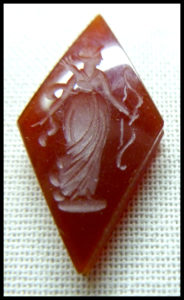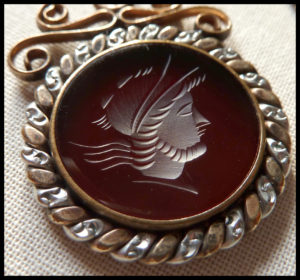CARNELIAN
When I first started collecting intaglios, one of the first terms I heard which referred to the reddish-orangish-brownish colored stones that are used for many of the engravings was “carnelian”. This semi-precious gemstone was highly prized in antiquity and, in fact, was still an oft used stone for the intaglios produced in the 18th and 19th centuries.
It’s good to know what carnelian is. The descriptive material provided below is selectively taken from the website “Minerals.net”, specifically from the page http://www.minerals.net/gemstone/carnelian_gemstone.aspx . The page provides much more information about carnelians and the website in general is a wealth of information about minerals and gemstones.
Carnelian is the red, orange, or amber variety of Chalcedony (a form of Quartz that is compact and microcrystalline). Though often a solid color, it may also be banded, in which case it would be jointly classified as both Agate and Carnelian. Carnelian is an ancient gemstone, having been used as gem material since antiquity. Although still used a gemstone today, its significance and value has been diminished since the ancient times.
Carnelian can sometimes have its classification borderline with other Chalcedony gemstones.
Sard, which is the brownish to brownish-red translucent form of Chalcedony, can sometimes be a color that can fall under either category. The name Sard can also be used interchangeably with Carnelian, though it is accepted that Carnelian on the redder spectrum and Sard on the browner spectrum. Sard has more historical significance over practical usage, as it is not commonly used as gemstone today.
Carnelian differs from Jasper in that Jasper will always be opaque, whereas Carnelian is translucent. Carnelian may be nearly opaque but will still let light through when viewed from the edges. Jasper usually also exhibits multicolored patterns and splotches which are lacking in Carnelian. Though Carnelian is often a solid color, it may contain lighter and darker zones within a single stone, or cloudy areas.
Most Carnelian is naturally colored, though some lighter-toned stones may be heat treated to enhance color. Some Carnelian on the market is dyed white Chalcedony or lightly colored Agate.
Sources of Carnelian include India, Brazil, Uruguay, and the Unites States (New Jersey and Oregon).

